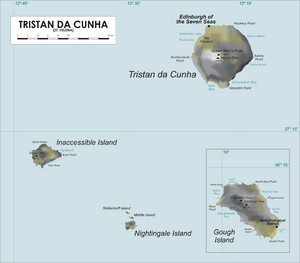Nightingale Islands facts for kids
The Nightingale Islands are a group of three small islands in the South Atlantic Ocean. They are part of the Tristan da Cunha territory. These islands include Nightingale Island, Middle Island, and Stoltenhoff Island. The United Kingdom manages them as part of its overseas territory of Saint Helena, Ascension and Tristan da Cunha. No people live on the Nightingale Islands.
Nightingale Island is the smallest of the four main islands in the Tristan da Cunha Group. It is about 4 square kilometres (1.5 sq mi) in size. It lies 30 kilometres (18.6 mi) from Tristan and 22 kilometres (13.7 mi) from Inaccessible Island. Stoltenhoff and Middle Island are more like large rocks than typical islands.
Contents
Island Formation: A Look at Geology
Nightingale Island is what's left of a very old volcano. This volcano was once much bigger than it is today. Scientists have studied the rocks to learn about its age. The oldest rocks found on the island are about 18 million years old.
The most recent volcanic activity happened around 39,000 years ago. This was discovered by studying peat (a type of soil) that was covered by volcanic ash.
A Brief History of the Islands
The Dutch explorer Jan Jacobszoon first saw these islands in 1656. He called them "Gebrooken (Broken) island." However, his crew could not find a safe place to land. The first landing likely happened in 1696, possibly by Willem de Vlamingh.
Later, in 1767, a Frenchman named D'Etchevery also visited the islands. The islands were renamed Nightingale in 1760. This new name honored British captain Gamaliel Nightingale.
In 1811, Jonathan Lambert tried to change the name to "Lovel Island." He announced this in a newspaper called the Boston Gazette. But like his other suggested name changes, this one did not last.
Amazing Wildlife and Birds
Even though Nightingale is a tiny island, it is home to a huge number of seabirds. More than three million pairs of seabirds live here! Almost every part of the island that has plants is covered with nests. There are about 1.3 pairs of birds for every square meter.
The Wilkins's Buntings are very special birds. They are found only on these islands and nowhere else in the world.
Important Bird Areas: A Safe Home for Birds
The Nightingale Islands are known worldwide as a very important place for birds. They are part of the Tristan da Cunha Endemic Bird Area. This means many birds that live here are found only in this region.
BirdLife International has also named the Nightingale Islands an Important Bird Area (IBA). This is because many seabirds come here to breed. It's also home to unique landbirds.
Some of the important birds found here include:
- Northern rockhopper penguins: Up to 125,000 pairs breed here.
- Sooty albatrosses: Around 250 pairs.
- Atlantic yellow-nosed albatrosses: About 5,000 pairs.
- Broad-billed prions: Around 10,000 pairs.
- Soft-plumaged petrels: Up to 1,000 pairs.
- Great shearwaters: Up to 3 million pairs!
- White-faced storm petrels: Around 10,000 pairs.
- White-bellied storm petrels: About 1,000 pairs.
- Antarctic terns: Up to 400 pairs.
- Southern skuas: Up to 500 pairs.
- Tristan thrushes
- Wilkins's buntings
- Nightingale buntings
Other nearby islands, Gough and Inaccessible Island, are also recognized as important wetlands. They are protected under the Ramsar Convention.
Ocean Life: Aquatic Biodiversity
The people of Tristan da Cunha rely a lot on the fish around these islands. They use fish for food and as bait for their rock lobster fishing business. About 61.5 tons of fish are caught each year for these uses.
Because the island ecosystem is isolated, it can be easily harmed by too much fishing. Most fish species here stay around the islands for their whole life cycle. This means their populations are separate and don't get new fish from other areas. So, it's important to manage fishing carefully to keep these fish populations healthy.
See also
 In Spanish: Islas Ruiseñor para niños
In Spanish: Islas Ruiseñor para niños




